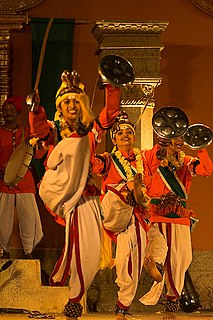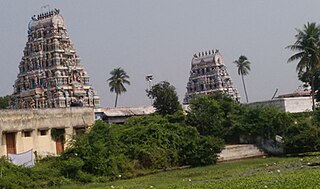
In Hinduism, Daksha is one of the Prajapati, the agents of creation, as well as a divine king-rishi. He is also a Manasputra, mind created son of the creator god Brahma. The artwork shows him as an obese man with a stocky body, protruding belly, and a handsome face or the head of a goat. Scriptures mention two Daksha, born in two different Manvantara (ages).

Vīrabhadra, also known as Veerabadhra, Veerabathira, Veerabathiran is an extremely fierce and fearsome form of the Hindu god Shiva. He was created by the wrath of Shiva and destroyed the Yagna of Daksha, after Daksha's daughter and Shiva's consort Sati self-immolated in the sacrificial fire. He is described as a warrior who eventually blinded Bhaga, subdued Indra and broke, among many other countless gods, Pushan's teeth. Other gods fled the battlefield unable to sustain his power.

Maharishi Bhrigu was one of the seven great sages, the Saptarshis, one of the many Prajapatis created by Brahma. The first compiler of predictive astrology, and also the author of Bhrigu Samhita, the astrological (Jyotish) classic, Bhrigu is considered a Manasa Putra ("mind-born-son") of Brahma. The adjectival form of the name, Bhargava, is used to refer to the descendants and the school of Bhrigu. According to Manusmriti, Bhrigu was a compatriot of and lived during the time of Manu, the Hindu progenitor of humanity. Bhrigu had his Ashram (Hermitage) on the Vadhusar River, a tributary of the Drishadwati River near Dhosi Hill in the Vedic state of Brahmavarta, presently on the border of Haryana and Rajasthan in India. Along with Manu, Bhrigu had made important contributions to Manusmriti, which was constituted out of a sermon to a congregation of saints in the state of Brahmavarta, after the great floods in this area. As per Skanda Purana, Bhrigu migrated to Bhrigukutch, modern Bharuch on the banks of the Narmada river in Gujarat, leaving his son Chyavana at Dhosi Hill.

Sati, also known as Dakshayani, is the Hindu goddess of marital felicity and longevity, and is worshipped as an aspect of the mother goddess Shakti. She is generally considered the first wife of Shiva, other being Parvati, who was Sati's reincarnation after her death.

The Shakti Pitha are significant shrines and pilgrimage destinations in Shaktism, the goddess-focused Hindu tradition. There are 51 Shakti peethas by various accounts, of which 18 are named as Maha (major) in medieval Hindu texts.

The Vishalakshi Temple or Vishalakshi Gauri Temple is a Hindu temple dedicated to the goddess Vishalakshi, at Mir Ghat on the banks of the Ganges at Varanasi in Uttar Pradesh, India. It is generally regarded as a Shakti Pitha, the most sacred temples dedicated to the Hindu Divine Mother.

Veeragase is a dance form prevalent in the state of Karnataka, India. It is a vigorous dance based on Hindu mythology and involves very intense energy-sapping dance movements performed by Jangama. Veeragase is one of the dances demonstrated in the Dasara procession held in Mysore. This dance is performed during festivals and mainly in the Hindu months of Shravana and Karthika. It is performed at all important functions of Lingayat household.

Kalighat Kali Temple is a Hindu temple in Kalighat, Kolkata, West Bengal, India dedicated to the Hindu goddess Kali. It is one of the 51 Shakti Peethas.

Dakshayagnam is a 1962 Indian Telugu-language Hindu mythological film, produced and directed by Kadaru Nagabhushanam under the Varalakshmi Pictures banner. It stars S. V. Ranga Rao, Devika, and N. T. Rama Rao, with music composed by Saluri Hanumantha Rao. This was N. T. Rama Rao's 100th film which was also dubbed in Tamil with the same title.

Daksheswar Mahadev or Daksha Mahadev temple is a Hindu temple dedicated to Lord Shiva, located in the town of Kankhal, about 4 km from Haridwar, Uttarakhand, India. It is named after King Daksha Prajapati, the father of Sati. Daksha is one of the fourteen Prajapatis, creator deities, who preside over procreation and are the protector of life in Hindu mythology.

Yajna or Yajneshwara is mentioned as an avatar of the Hindu god Vishnu in the Bhagavata Purana. As Yajna, Vishnu is the embodiment of the Hindu sacrifice ritual or Yajna. He was also Indra of the Svayambhuva Manvantara, the era of Svayambhuva Manu. His father rushi; mother Aguthi.
Dakshayagnam is a 1938 Indian Tamil-language film directed by Raja Chandrasekhar. It starred V. A. Chellappa, N. S. Krishnan, T. A. Mathuram in the main roles. M. G. Ramachandran played a minor role in the film as Vishnu. The film was the first sound version based on Daksha yajna, the story of Daksha.

Shailaputri (शैलपुत्री), is the daughter of the Mountain King Himavat, and is a manifestation of the Hindu Mother Goddess, Durga. She is the first Navadurga venerated during the first day of Navratri, and is a reincarnation of Goddess Sati. She is also known as Goddess Parvati.

Kottiyoor Ulsavam or Kottiyoor Vysakha Mahotsavam is a 27-day annual pilgrimage observed by Hindus commemorating the Mythology of Daksha Yaga. The pilgrimage is similar to the Kumbh Mela of Prayag, where ablutions are performed. The temple and grounds are also known as Dakshina Kasi.

In Hindu mythology, Daksha-Yajna(m) or Daksha-Yaga is an important event, which is narrated in various Hindu scriptures. It refers to a yajna (sacrifice) organized by Daksha, where his daughter Sati immolated herself. The wrath of god Shiva, Sati's husband, thereafter destroyed the sacrifice. The tale is also called Daksha-Yajna-Nasha. The story forms the basis of the establishment of the Shakti Peethas, temples of the Hindu Divine Mother. It is also becomes a prelude to the story of Parvati, Sati's reincarnation who later marries Shiva.
Kratu was a rishi who appeared in two different ages. In the Swayanbhuva Manvantara, Kratu was a Prajapati and a very dear son of Lord Brahma. He was also the son-in-law of Prajapati Daksha. His wife was named Santhati. It is said that he had 60,000 children. They were named as included in the Valakhilyas. Kratu also had 2 sisters, Punya and Satyavati.

Bohuwa Dance Bohuwa is a traditional event of the Sonowal Kacharis. This event is celebrated by Sonowal Kacharis every two years in Dibrugarh, Lakhimpur (Bihpuria), Assam.

Pattiseema Veerabhadra Swamy temple – Pattisam temple is on hill Devakuta in midst of river Godavari. Veerabhadra temple pattiseema is Pancha Kashi Kshetram. It is Island in Polavaram mandal, West District, Andhra Pradesh.

Nandikeshwari Temple, also known as Nandikeshwari Tala, is located in Sainthia city of West Bengal. This temple is part of the famous Shakti Peethas in Indian Subcontinent.

Veerateswarar Temple is a Hindu temple located at Keelaparasalur in Mayiladuthurai district of Tamil Nadu, India. The historical name of the place is Tirupparialur. The presiding deity is Shiva in the form of Veerateswarar and his consort is known as Ilam Kobanayal. The presiding deity is revered in the 7th century Tamil Saiva canonical work, the Tevaram, written by Tamil saint poets known as the nayanars and classified as Paadal Petra Sthalam, the 276 temples that find mention in it.
















